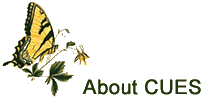|
|

Back to About CUES
Back to About CUESThe Sustainable Urban Landscapes Information Series, University of Minnesota, Sustainable Landscape Design
Visit the web site called the Tree of Life.
This web site will allow you to understand insect classification. It has beautiful pictures and descriptions as it places arthropods and insects in their appropriate rank in the classification. This is the best reference on the web for classifying insect orders.The National IPM Network home page provides links to regional IPM networks.
Visit Radcliffe's IPM World Textbook
This web site, hosted by the Department of Entomology at the University of Minnesota, is part of the National IPM Network. The site was created by two professors in entomology, Ted Radcliffe and Bill Hutchinson. It contains numerous papers on IPM management in various crop and commodity systems. In addition, you visit the section called Fabulous Web Sites and link to other web sites. You can select these additional web sites to learn more about biological control, IPM, and insect pest life history. Please visit yourself and see. Visit the VegEdge
Maintained by Bill Hutchison in the Department of Entomology at the University of Minnesota, this site provides information about IPM in vegetable crops and lots of other stuff on veggies.Visit the gypsy moth web site at Virginia Polytechnical University.
This web site has beautiful pictures of the life stages on the gypsy moth as well as life history information.Visit the Ohio State University web site called Plant Facts.
You can search for extension leaflets on Japanese beetle, bronze birch borer, oystershell scale, hackberry nipple gall, etc. Use the search engine to find extension bulletins from around the US on IPM and pest control for landscapes and turf.Visit Cornell University's Biological control: A Guide to Natural Enemies in North America
This site covers four basic categories of bio-control agents: parasitoids, predators, pathogens, and weed feeders.Visit the National Park Service IPM Manual
The National Park Service is proud to be a leader among federal agencies in the implementation of IPM. With over 80 million acres of land, 45,000 buildings and cultural landscapes ranging from croplands to historic rose gardens, they face every conceivable pest problem.
Since implementing an IPM program in the early 1980's, the Park Service has reduced pesticide use by over 60 percent while improving the effectiveness of our pest management efforts. Key elements in this success were formal training and the provision of printed and audiovisual materials. One of our products is an IPM Manual which is now available in a second edition. It provides descriptions of the biology and management of 21 species or categories of pests. The Park Service is pleased to offer this information to the IPM community. Visit the University of Wisconsin Virtual Foliage with aids for plant identification
Welcome to the Virtual Foliage Home Page! The Department of Botany at the University of Wisconsin-Madison maintains five sets of digital images for use with our courses. The General Botany set consists of over 2,000 pictures organized within the context of an introductory botany course.Search and Browse the EXTOXNET Pesticide Information Profiles (PIPs)
EXTOXNET is a cooperative effort of University of California-Davis, Oregon State University, Michigan University, and Cornell University.Colorado State Cooperative Extension Publications on Gardening
This site provides access to all extension publications in Colorado on landscape pests and horticulture.North Carolina State University: Plant Diseases and Insects
North Carolina State University, Department of Entomology Insect Notes
North Carolina Cooperative Extension leaflets on Ornamental and Turf IPM
North Carolina Cooperative Extension leaflets on Turf Insects
The Plant Pathology Internet Guide Book
This British web site has excellent information on pathogens, insects, and IPM.USDA Forest Service St Paul field office
University of Kentucky, Department of Entomology Landscape Insect Fact Sheets
 |
(C) Regents of the University of
Minnesota. All rights reserved. |
 |
 |